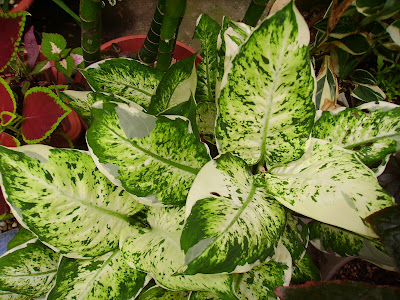
These are the dumbcane species I have in my garden. I realise now that these are now known as Dieffenbachias and the common name "dumbcane" seemed to be slowly fading. What a strange name for a plant, later I found that its because the name commemorates Ernst Didffenbach, a German physician.
I started liking dumbcanes because of their variegated patterned leaves. There seemed to be some new species sold in supermarket for a very affordable prices in every few months. These are my favourites. I have yet to identify their specific names but then, its ok (They all represent like birds of a feather)
If you have the intention to have a white or cream coloured theme garden, do choose these. They are hardy and easy to maintain. They can also able handle neglect when not watered for few days. I guess the cane stores the energy & food supply.
Though they are beautiful, these are touch me not type of plant. The leaves are poisonous & may cause rashes. I had suffered burning sensation on my hands when I was trimming the excess roots as I was replanting it. Watch out for the milk sap.
Do keep them in distance where you would not brush when come in contact when walking in the garden. In the morning, water droplet form at the tip of these leaves. Those too are poisonous. I would not recommend them to use their leaves for flower arrangements, unless its more likely placed in area where is it seem but not touched.
Probably I like the idea of danger in my garden. Like having carnivores plants, poisonous but beautiful flowers. If you do, I strongly suggest not to plant a herb or vegetable plant beside these. You don't want to consume some tomatoes or greens and find that you loose your voice.
I got more information about this plant in my blog which I don't want to repeat myself here.
Do check on here for more info: Dumbcane

































15 comments:
Hello James! thank you for the warning. I didn't realise how dangerous they are. Your collection of Dieffenbachias are admirable. I like the one with longer leaves with lots of white (3rd & 4th photos). Have a great day!
What charming photos of the green and white foliage of the dieffenbachia, and I was not aware of its poisonous quality. We used to have some indoor houseplants and those were among them.
James, thank you for your kind thoughts on my blog, and we hope you and your family have a blessed day.
interesting...I didn't know these were so poisonous even the water droplets are dangerous!
Hi James, I thought that you may be interested in the common name of 'Dumb cane'.The foliage of the dieffenbachia contain significant amounts of the toxin oxalic acid. If small amounts of oxalic acid are eaten, the human body is normally quite capable of dealing with it. However, if more of the toxin is consumed over a reasonable period of time then you can expect to experience a number of unpleasant side effects. These would include weakness, burning in the mouth and throat, nausea, vomiting, diarrhoea and difficulties with breathing. Severe side effects would include convulsions, coma, and death from cardiovascular collapse.The effect of a burning sensation in the mouth and throat was picked up by early slave traders who would force feed dieffenbachia leaves to noisy or riotoius slaves. Their mouths and throats would swell, loosing their ability to speak - or worse - breath, hence the common name dumb cane. Not a very nice story but there you go. Comment left as requested, kind regards Simon.
Thank you Stephanie, Di & Wendy for your comments.
There are more poisonous plant than this one. Had researched and found that 100ml of the milksap can kill a mouse. Surface contact with the leaves may cause rashes depending on those who have sensitive skin. Never handle this plant when its wet (rain or early morning - dew)
Simon - Didn't know that it got history with slaves. Wow - thanks for the info.
It's a beautiful plant. I had it as a houseplant. My mistake was to put it on a spot that got a lot of hot sun. It didn't like it and was gone. Your pictures are great! I love all the varieties.
It is a lovely plant. The variegation occurs in such varying ways on each variety of the plant. Had no idea they were so poisonous. James, thanks for your comment on my blue post. It is wonderful to have you come visit my blog.
Hi James,
I didn't realize there were that many kinds of those. You have a great collection. I used to have one I grew as a houseplant.
The foliage here looks very healthy and fresh. You grow them well. I didn't know that they are poisonous. Lucky to have read your post today.
Thanks Tatyana, Mary Delle, Sue & Belle for your comments. I guess many didn't realise about the poisonous part. Glad to hear from all you all.
Hi James,
Simons' comment was very interesting about the slavery. Kind of sad, too.
Nice photos, and now I will know to keep this in the shade!
Hi James, So glad to have found your site, I lived in Singapore for many years and visited Malaysia often. Great memories of a wonderful part of the world. Must get back there soon.
James, I awarded you the Best Blog Award today. You may want to but you don't need to do the chain letter thing which is quite tedious. I think you deserve the Best Blog Award and I wish you will display it in you blog.
Rosey - yes, very interesting & do keep them in shade.
Barry - thanks for the comment & adding me in as a follower. You got a nice blog too.
Belle - Thanks for the award, appreciate it very much.
Post a Comment